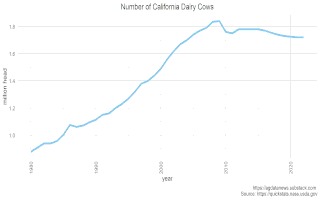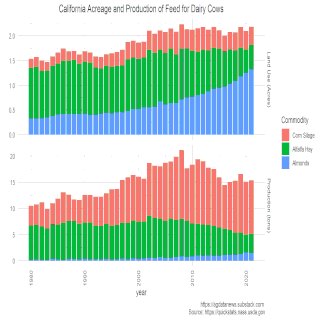By Aaron Smith
They eat the part people don't want---the hull, which is the soft case that protects the nut while it grows.
California currently has 1.7 million dairy cows. The herd doubled between 1980 and 2009, reaching a peak of 1.84 million before declining somewhat in the ensuing years. In most years, milk generates more revenue than any other California farm product, just ahead of grapes and almonds. California produces more milk than any other state.

Cows need to eat. In California, dairy cow rations include grains, oilseeds, silage, and roughage. Grain and oilseed products such as corn, distillers grains, canola, soybean meal are relatively inexpensive to transport; they are mostly produced in the Midwest and brought to California by train. Silage and roughage are more expensive to transport, and so they tend to be produced locally. Silage is made mostly from corn, and roughage used to come mostly from alfalfa hay.
Alfalfa acres have declined by 50% since 2000. Over the same period, almond acres have doubled. California farmers now harvest more acres of almonds than any other crop, and almonds are now the most valuable crop in the state ahead of grapes. I wrote about this phenomenon in my first Ag Data News article.
This would seem to create a problem for dairy farmers. Fewer alfalfa acres means less hay available for cows. However, it turns out that almond hulls make an excellent substitute for alfalfa in dairy rations. They have similar fiber content, more sugars, and less protein. Almond hulls also tend to be substantially less expensive than hay.

Has the increase in almond hulls been enough to offset the lost alfalfa?
According to the CDFA cost of production survey, Holstein dairy cows eat about 12 pounds of roughage and 12.5 pounds of silage per day (dry weight). A pound of shelled almonds produces about 1.46 pounds of hulls (dry weight), so I estimate almond hull production as 1.46 times the production of shelled kernels.
About 35% of alfalfa hay is of premium or supreme quality, so I estimate alfalfa hay available for dairy rations as 35% of alfalfa hay production. The dry weight of corn silage is about 35% of its fresh weight, so I multiply corn silage production by 0.35. The different protein and sugar composition of hulls and hay means that farmers would need to adjust other rations if they were to substitute hay for hulls. I will ignore such realities in this calculation.
These calculations, simplistic as they are, suggest that the increase in almond hulls been enough to offset the lost alfalfa and to provide sufficient roughage for California's dairy cows.
Corn silage availability has moved with dairy cow numbers, increasing through 2008 and declining somewhat since that time. This suggests that good substitutes for silage are too expensive and therefore that corn silage acreage is likely to remain around its current levels for as long as dairy cow numbers do the same.

Almond hulls are a byproduct of almond production; they would be grown and harvested whether or not the hulls could be fed to cows. Other byproducts fed to dairy cows include cottonseed and grape pomace (the leftovers after grapes are crushed for wine or juice).
By feeding almond hulls to cows, California farmers have mitigated the cost of losing alfalfa acreage to almonds. This story illustrates the interconnections across parts of the agricultural system; changes in one part of the system can have large effects on other parts. These interconnections are important to consider as we contemplate the challenges posed by persistent droughts and reduced water availability.
Put differently, beware of the law of unintended consequences.
I made the graphs in this article with this R code.
Postcript: For more on byproducts in California dairy rations, I recommend this ARE Update article by ARE PhD student Scott Somerville and co-authors. Scott was very helpful with the calculations in this article, for which I’m very thankful. (A couple of years ago, Scott wrote an interesting Ag Data News article on the resurgence of oats as a trendy food product.)
Source : ucdavis.edu